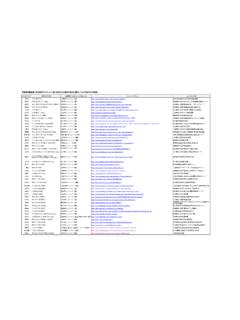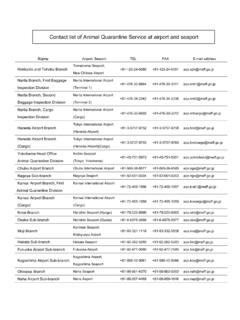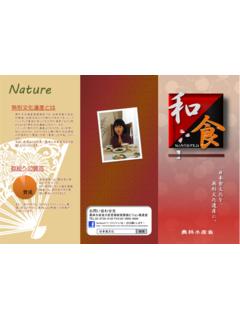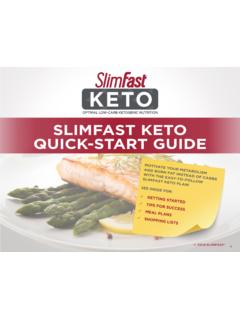Transcription of Traditional Dietary Cultures of the Japanese - maff.go.jp
1 Traditional Dietary Cultures of the Japanese Itadaki-masu WASHOKU - Cultures that should be preserved What exactly is WASHOKU? Maybe even Japanese people haven't thought seriously about it very much. Typical washoku at home is usually comprised of cooked rice, miso soup, some main and side dishes and pickles. A set menu of grilled fish at a downtown diner is also a type of washoku. Recipes using cooked rice as the main ingredient such as curry and rice or sushi should also be considered as a type of washoku. Of course, washoku includes some noodle and mochi dishes. The world of Traditional washoku is extensive.
2 In the first place, the term WASHOKU does not refer solely to a dish or a cuisine. For instance, let's take a look at osechi- ryori, a set of Traditional dishes for New Year. The dishes are prepared to celebrate the coming of the new year, and with a wish to be able to spend the coming year soundly and happily. In other words, the religion and the mindset of Japanese people are expressed in osechi-ryori, otoso (rice wine for New Year) and ozohni (soup with mochi), as well as the ambience of the people sitting around the table with these dishes. Food culture has been developed with the background of the natural environment surrounding people and culture that is unique to the country or the region.
3 The Japanese archipelago runs widely north and south, surrounded by sea. 75% of the national land is mountainous areas. Under the monsoonal climate, the four seasons show distinct differences. The average annual precipitation is as high as 1800mm. In such natural environment, the people are obtaining the wealth of seasonal foodstuff from the sea, mountains and fields. Japanese people respect and live with nature, which brings such blessings to people's lives. With belief in deities and ancestors, combined with foods, a unique food culture has been developed in this land. Food culture in Japan has been developed by also incorporating foreign Cultures from China, Korean Peninsula and Southeast Asia, and from West European countries in the modern era.
4 As a result, delicious and healthy WASHOKU that Japan can boast to the world developed. However, such tradition of WASHOKU is now disappearing from Japanese tables. While WASHOKU had been developed by using foodstuff grown in Japan, the food self-sufficiency ratio of Japan is now lower than 40%. Household consumption of rice is decreasing, and Traditional local cuisines and dishes specially prepared for certain events are also disappearing. In its long history, Japan has developed WASHOKU as something beyond mere cuisine but culture . Let us explore the history of WASHOKU, the Traditional food culture in Japan, in this booklet.
5 WASHOKU. CONTENTS. 01 [Prologue] WASHOKU Cultures that should be preserved 03 [What is WASHOKU?] Foodstuff, dishes, nutrition and hospitality; the occasion and style of eating are also important elements of WASHOKU. 05 The reason why WASHOKU is a part of Japanese culture 07 [(1) Respect for nature] WASHOKU started from respecting nature and has continued to the present 09 [(2) Uniting family and region] Gathering to connect ties among people; role of foods for events and festivals 11 [(3) Wish for health and longevity] Wish for health and longevity with dishes for special occasions 13 [(4) Diversity of WASHOKU] The climate generated diversity, depicting the map of WASHOKU.
6 15 [Chronological table of WASHOKU] The road WASHOKU takes Characteristics of WASHOKU. 17 [(1) Menu structure] Soup and dishes are for eating cooked rice. One soup and three dishes is the basic style of washoku 19 [(2) Foodstuff] Foodstuff at the base of washoku; The secret of deliciousness and diversity 21 [(3) Cooking] Cut, stew, grill, steam, boil, dress, Arrange the foodstuff this way and that to make it even tastier. 23 [(4) Flavor] Umami, the greatest wisdom discovered by Japanese people to eat deliciously . 25 [(5) Nutrition] WASHOKU is the ideal model of nutritional balance 27 [(6) Arrangement] Mindset and formality of welcoming people 28 [(7) Chopsticks and bowls] Chopsticks and bowls that support WASHOKU.
7 29 [(8) Sake] Japanese sake that accentuates the appeal of WASHOKU and relaxes your mind 30 [(9) Japanese sweets and Japanese tea] Wagashi ( Japanese sweets) and tea that are close to people's lives 31 [Necessity of Dietary education] WASHOKU is now endangered. How can we hand it down to future generations? 34 [Epilogue] The future of WASHOKU. [Editorial Committee] Principal: Isao Kumakura; Committee members: Ayako Ehara, Hiroko Okubo, Takuya Oikawa; Advisor: Shigeyuki Miyata; Edited by: Magazine House, Ltd.; Art direction and design: Kaori Okamura; Cover illustration: Kawanakayukari (tento). Translation; MAFF (Ministry of Agriculture, Forestry and Fisheries).
8 * In this booklet, the Traditional Dietary culture of Japan is expressed as WASHOKU, and dishes with such tradition are expressed as washoku. 2. Foodstuff Dishes Foodstuff used in WASHOKU includes grains (mainly rice), The basic structure of WASHOKU is one soup and three vegetables, mushrooms, fish, shellfish and seaweed. Delicious dishes other than cooked rice. Such structure comprises wagyu beef is also used in recent years. There are two types of dishes that take full advantage of the deliciousness of the rice: non-glutinous rice and glutinous rice. The variety of vegetables ingredients themselves.
9 The key for every dish is dashi (stock). ranges widely from indigenous varieties to Western vegetables that It may be prepared from kombu (dried kelp) or katsuobushi arrived in the Meiji period and thereafter. Fish is also an abundant (dried bonito), or by cooking ingredients for a certain time. foodstuff, and there are as many as about 4,200 varieties of fish Deliciously prepared dishes are served in beautiful style. around Japan. What is WASHOKU? Foodstuff, dishes, nutrients and hospitality; the occasion and style of eating are also important elements of WASHOKU. WASHOKU starts from selecting foodstuff.
10 Then, the menu is composed by taking nutrition into consideration. Then, the dishes are served with a mind of hospitality. How to eat the dishes is also an important element. WASHOKU. We use the term as a word expressing Japanese -style cuisine. the word as a collective term for the Traditional Dietary Cultures of Japan. However, does the term WASHOKU merely represent a single style of cuisine? WASHOKU is constantly changing over time. For example, itadaki-masu and gochisou-sama, the phrases Japanese people say before and after meals, respectively, express thanks to not only the The basic structure of WASHOKU is one soup and three dishes, which person who prepared the meal, but also to nature in which the foodstuff was means eating cooked rice with side dishes, soup and pickles.












